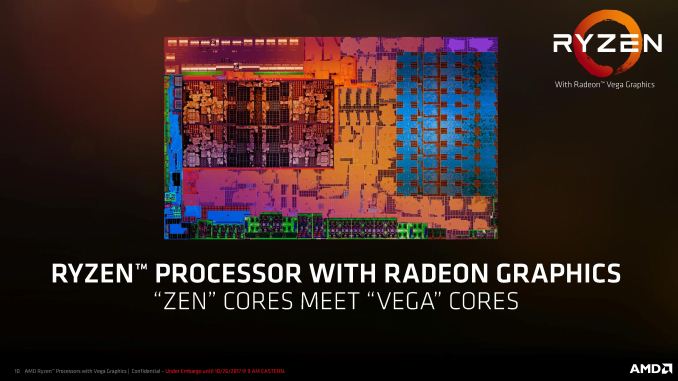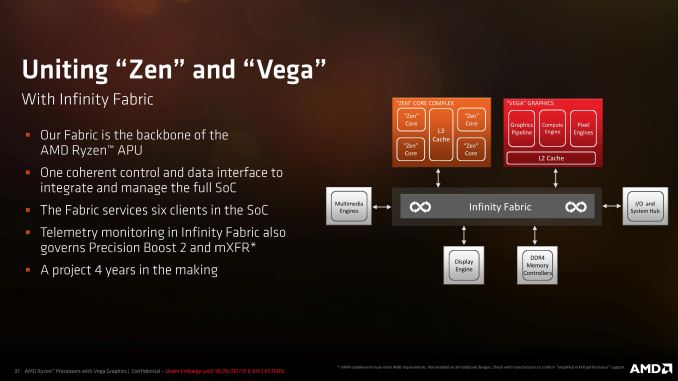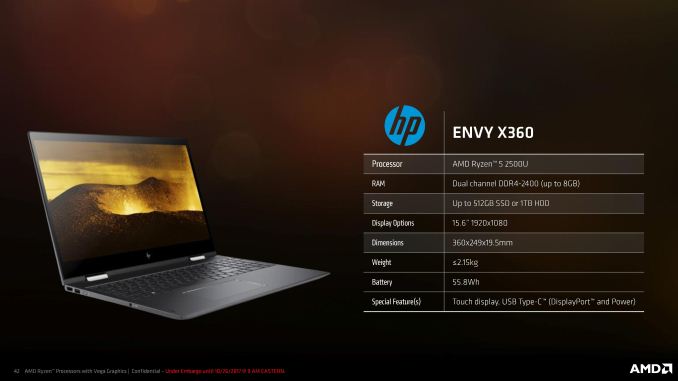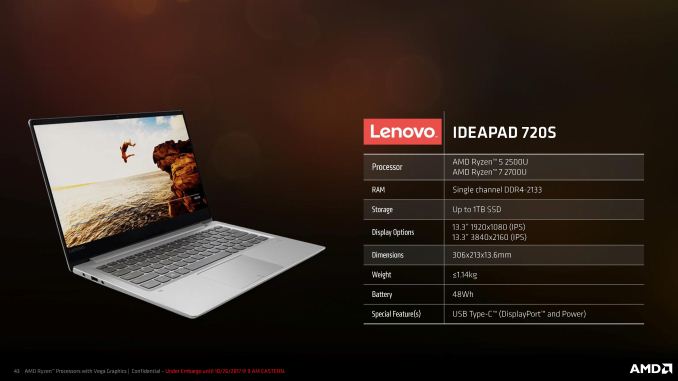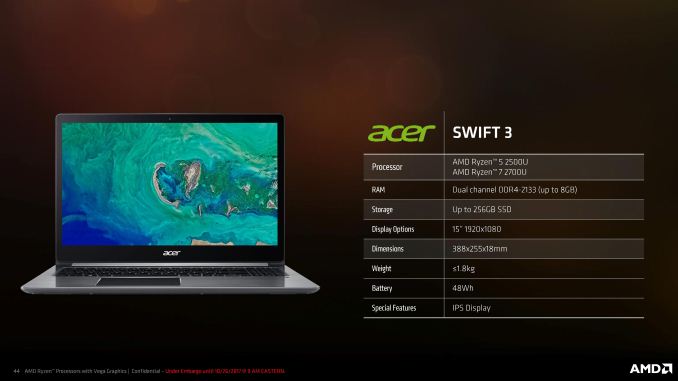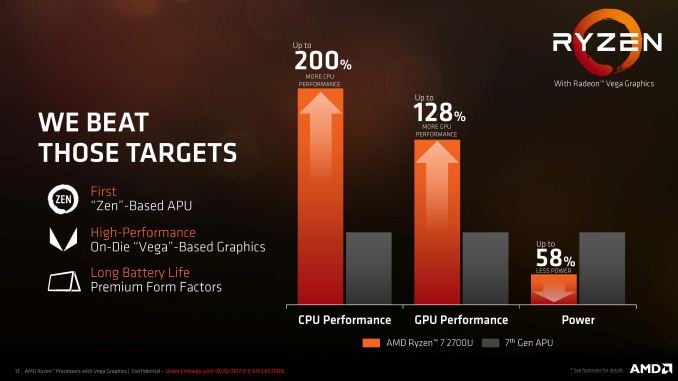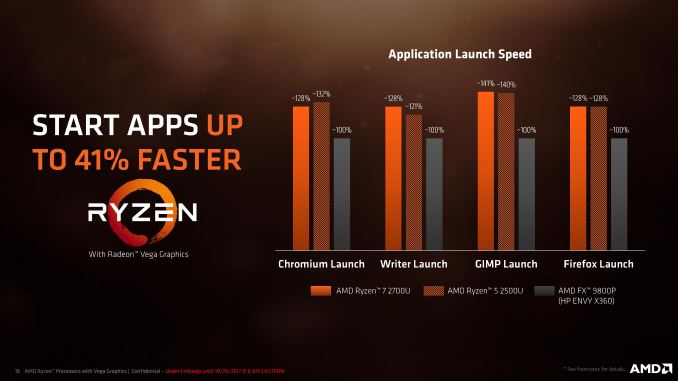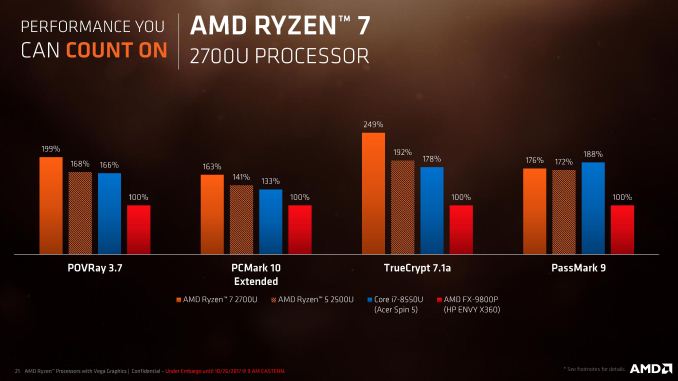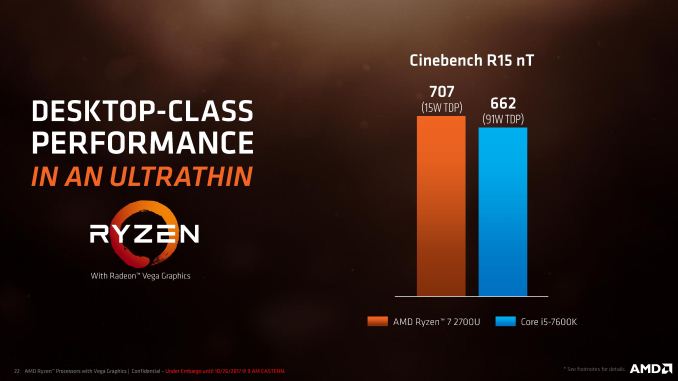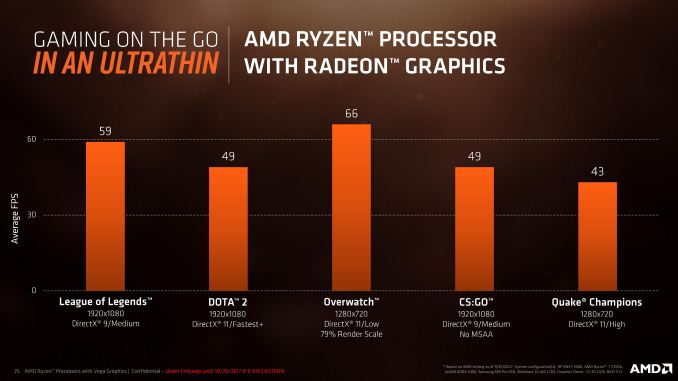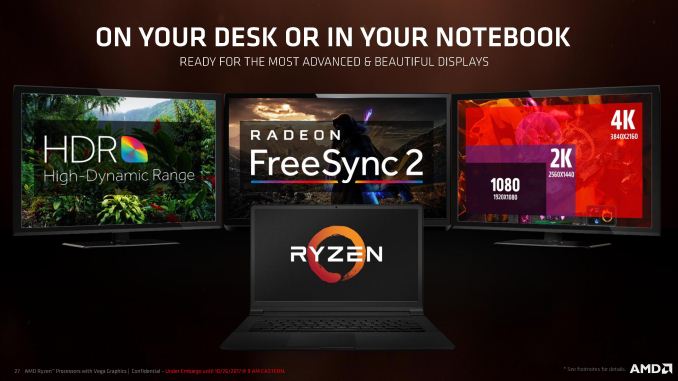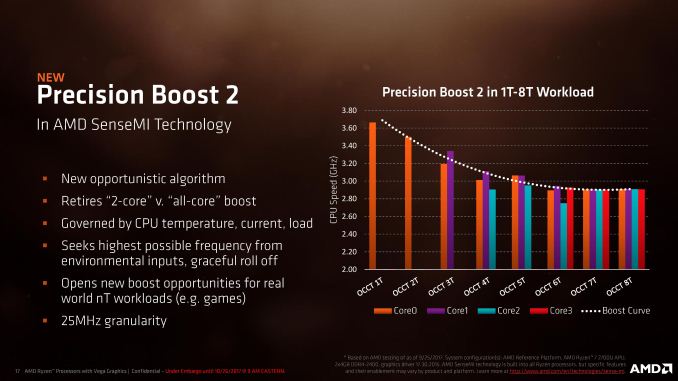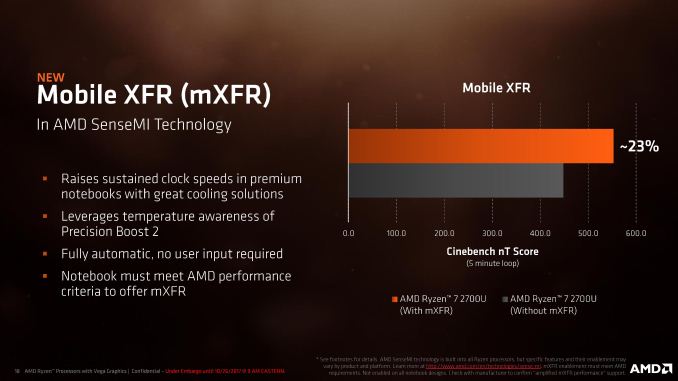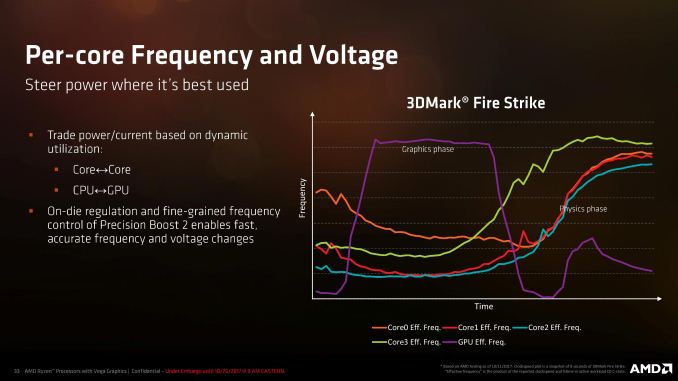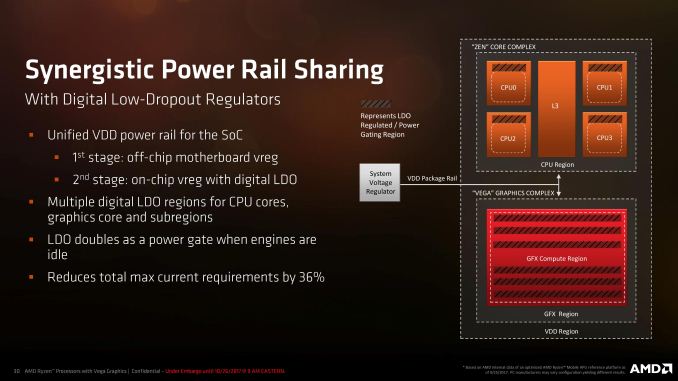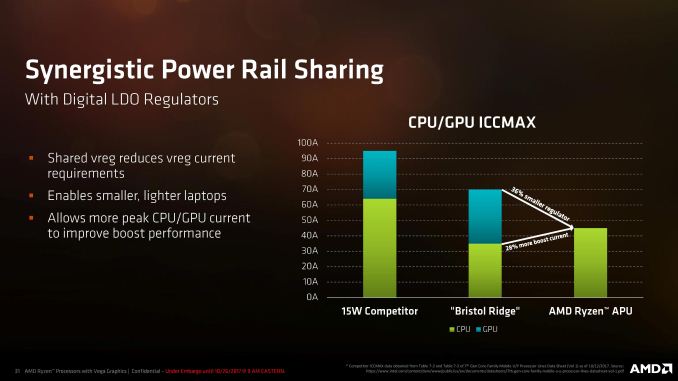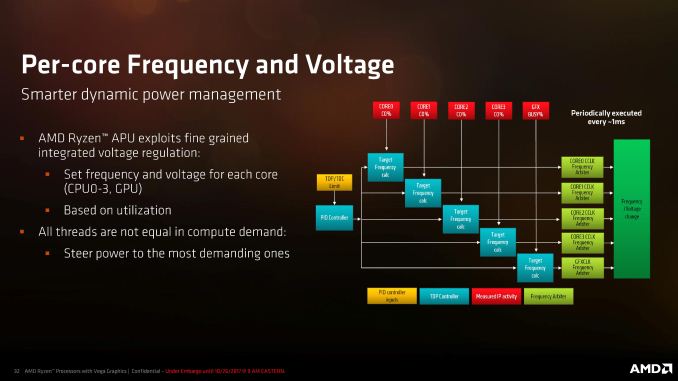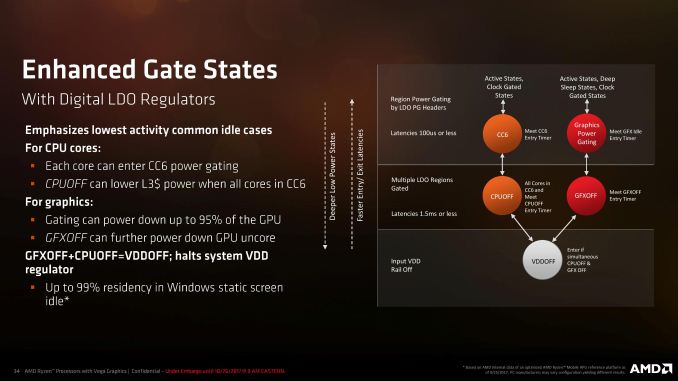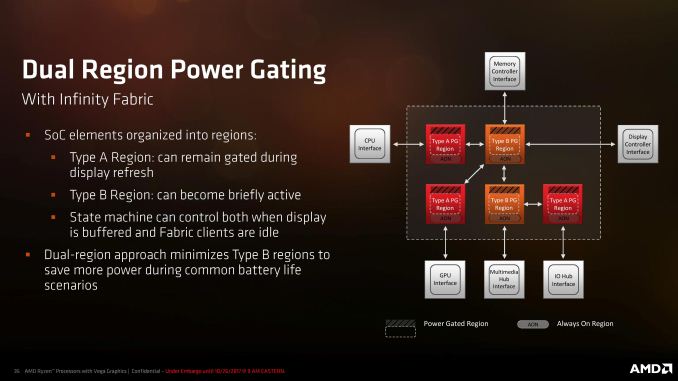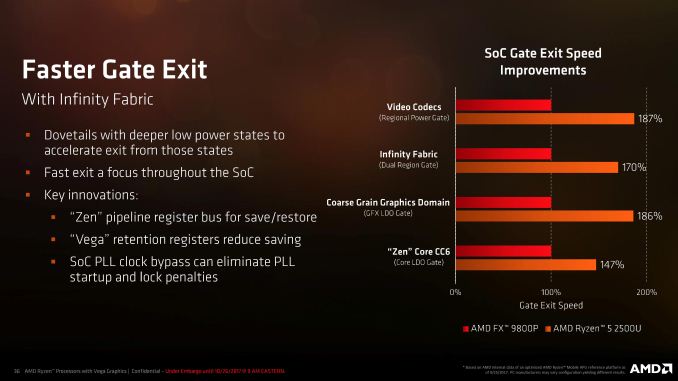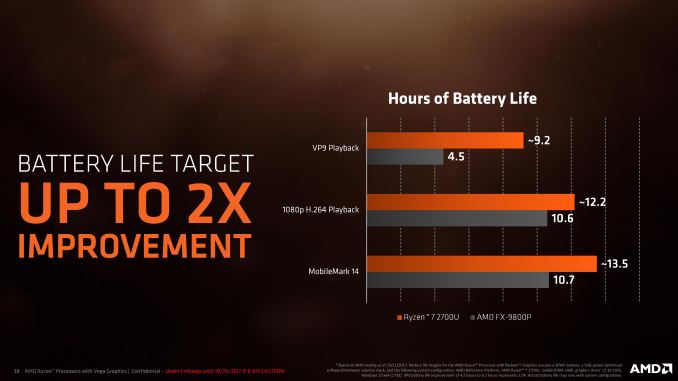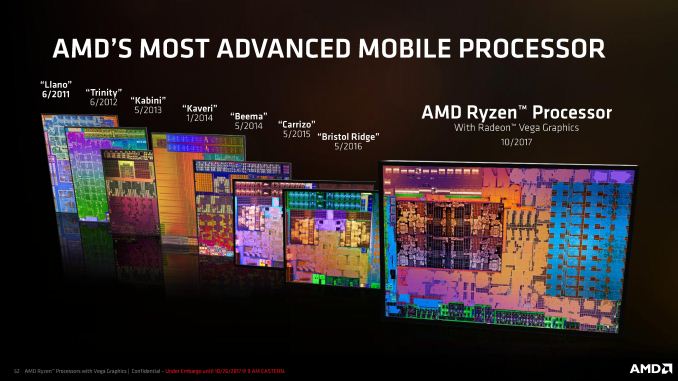
Original Link: https://www.anandtech.com/show/11964/ryzen-mobile-is-launched-amd-apus-for-laptops-with-vega-and-updated-zen
Ryzen Mobile is Launched: AMD APUs for Laptops, with Vega and Updated Zen
by Ian Cutress on October 26, 2017 9:00 AM EST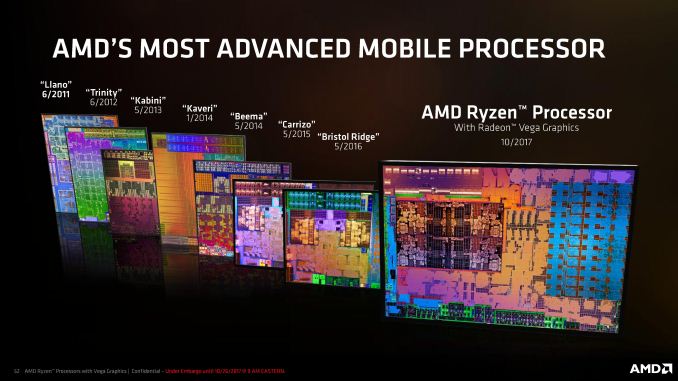
The final piece of AMD’s return to high-performance computing is in laptops. While Ryzen, Threadripper, and EPYC have used the 8-core Zeppelin building block for their products, the laptop side of the equation will combine the new high-performance Zen core with the latest Vega graphics in a single piece of silicon. AMD is now set to release the results of their efforts: a single silicon chip offering four Zen cores, up to 10 Vega compute units, and a unified power delivery system all in under 15W, with AMD touting +200% CPU performance and +128% GPU performance over its previous generation of laptop processors. HP, Lenovo and Acer are releasing laptops based on the Ryzen Mobile hardware today (or soon), and we expect to see more OEMs at CES in January with their offerings.
Two APUs Now, More Later
To start, AMD is launching a pair of low-power processors for the laptop market: the Ryzen 7 2700U and the Ryzen 5 2500U. Both of these processors combine four of AMD’s latest Zen cores, with some minor improvements, with AMD’s latest Vega graphics, into a single piece of silicon. These are both 15W processors, using the U-suffixed nomenclature that Intel has popularized for its 15W parts. By developing around a 15W TDP, AMD is aiming for the same range of thin and light notebooks that are currently almost entirely Intel-powered, while also using the Vega graphics architecture as a significant selling point in gaming and enthusiast workload acceleration. AMD has also gone into detail about a number of power-saving technologies that is has developed and implemented to provide better battery life.
| AMD Ryzen Mobile APUs | |||
| Ryzen 7 2700U with Vega 10 |
Ryzen 5 2500U with Vega 8 |
FX-9800P (2015) |
|
| CPU | Quad-Core with SMT 2.2 GHz Base 3.8 GHz Turbo Zen Cores, 14nm |
Quad-Core with SMT 2.0 GHz Base 3.8 GHz Turbo Zen Cores, 14nm |
Dual Module 2.7 GHz Base 3.6 GHz Turbo Excavator, 28nm |
| GPU | Vega 10 10 CUs (640 SPs) Up to 1300 MHz |
Vega 8 8 CUs (512 SPs) Up to 1100 MHz |
GCN 1.2 8 CUs (512 SPs) Up to 758 MHz |
| TDP | 15W | 15W | 15W |
| DRAM | Up to DDR4-2400 | Up to DDR4-2400 | Up to DDR4-1866 |
| L2 Cache | 512 KB/core | 512 KB/core | 1 MB/module |
| L3 Cache | 1 MB/core | 1 MB/core | - |
| PCIe Lanes | ? | ? | 8 x PCIe 3.0 |
| Die Size | 209.78 mm2 | 209.78 mm2 | 250.4 mm2 |
| Transistors | 4.95 billion | 4.95 billion | 3.1 billion |
| Launch | October 2017 | October 2017 | May 2016 |
Both APUs will have four CPU cores and simultaneous multi-threading, giving eight threads total. The rated base clock for the processors will be in the 2.0 GHz range, although AMD states that the typical all-core turbo will be much higher than this (more about it later). CPU boost frequencies are 3.8 GHz for the Ryzen 7 2700U and 3.6 GHz for the Ryzen 5 2500U, which sound very high for 15W processors but AMD has stated that this frequency combination is more in the efficiency sweet spot for the processor design. Like its competitor, OEMs can use these processors in configurable TDP modes, which AMD states are from 9W to 25W. We are under the impression that these power modes do not change the frequencies, but merely affect the turbo profile which we’ll discuss later.
The four cores will be in a single core complex (CCX), which AMD states will alleviate some of the questions about CCX-to-CCX latency that were present in the dual CCX design for the desktop processors. There is another cutback compared to the desktop: there is only 1MB of L3 cache per core rather than 2MB, giving a total of 4MB of L3 cache. AMD’s Zen cores use L3 victim caches, which for most CPU-based workloads have little effect; however the speed of this L3 will be important when it comes to using the integrated graphics.
The single silicon design has 11 Vega compute units onboard, of which the Ryzen 7 2700U will be able to use 10 of them, and the Ryzen 5 2500U will be able to use 8. These will be called ‘Vega 10’ and ‘Vega 8’ graphics respectively. AMD does not provide the base frequencies for the graphics, but does state that the maximum frequencies for the parts will be 1300 MHz and 1100 MHz respectively. One of AMD’s key discussion points in our briefings was around the ability to shift power between the CPU and the GPU to keep the maximum performance at all times.
Memory support for both processors is up to dual-channel DDR4-2400; although AMD stated that it will be up to the laptop OEMs to decide whether to sell the devices with two memory modules. Some of the feedback the OEMs get is the requirement to ‘potentially’ upgrade the memory inside at a later date, which necessitates shipping single channel devices and leaving a memory slot free, rather than replacing two memory modules at once. The new Ryzen Mobile processors use AMD’s Infinity Fabric interconnect between the CPU and GPU segments, which runs at half the clock rate of the memory, and AMD states it offers better bandwidth and lower latency than PCIe.
Ryzen Mobile-based Laptops Coming to Shelves
When we get the final press releases in hand there will be specific news stories for each of the laptops coming to market, but AMD shared some information ahead of time about how AMD is returning to thin and light notebooks that actually have a proper design ID. As we stated back in our analysis of the Carrizo platform, there were plenty of users who were interested in AMD APUs but in an Envy or a Swift-like chassis, rather than the bulky plastic reduced price parts that vendors were putting out instead. So the big plus here is that we get an HP Envy x360, an Acer Swift 3, and a Lenovo Ideapad 720S with Ryzen Mobile.
Read our news post on the HP Envy X360 with Ryzen Mobile here
The HP Envy is actually the biggest notebook of the three, offering a 15.6-inch 1080p IPS screen and dual-channel DDR4-2400, with a 55.8 Wh battery. Storage will be offered with SSDs up to 512 GB and HDDs up to 1TB, although we are waiting to know if that SSD storage is SATA or PCIe. At just under 5 lbs it is going to be a bit heavy, but the x360 part of the name means it has a rotating hinge, allowing for it to be used as a tablet or a tent, with a touchscreen as well. Power is provided over USB Type-C, which also supports the DisplayPort alt-mode. Pricing will start at $699 and it will be shipping from November.
The Lenovo system is the smaller one, coming in at 2.5 lbs, and offering either a 1080p IPS screen or a 4K (UHD) IPS screen. We were told that this design uses a repurposed chassis from an Intel version, but will be offered with both the Ryzen 7 2700U and the Ryzen 5 2500U processors. As with most popular notebooks, the Ideapad 720S will taper to a point at the edge, but at its thickest point it will be around half-an-inch – it has been a while since we saw an AMD notebook at that size. Lenovo will support a 48 Wh battery and Type-C charging with a DisplayPort alt-mode, with storage up to 1TB of SSD (again, no mention of SATA or PCIe). The downside is perhaps the memory support, at DDR4-2133 and only single channel with no room to upgrade to dual channel. Ultimately Lenovo is going to promote this for productivity that is not memory bandwidth limited over gaming.
The Swift 3 is a little different than the others – we were told that Acer has built this chassis to dissipate 25W of processor power rather than 15W, meaning that Acer is going to be taking advantage of longer turbo modes and better performance numbers than other Ryzen Mobile parts. It will come with a 15-inch 1080p display, although it will not be offered in touch screen, and storage will be up to 256GB of SSD (again, no mention of SATA or PCIe). Memory will be dual channel, although the system will only support 8GB of DDR4-2133, and there is no mention of potential upgradability there – we’ll wait for the final press release.
What Is New with Ryzen Mobile
Aside from the on sheet specifications and upcoming devices that will be using these parts, AMD also provided some performance metrics, some updates to the SenseMI technologies for Ryzen Mobile, as well as a look into the new power regulation system developed for these parts, a lot of which are upgrades to the basic AMD Zen design that will be featured in the next generation of desktop processors. We will cover these in the next few pages.
Notice: All benchmark results on this page are from AMD's announcement and slide decks. We want to get a sample to prove these are accurate.
AMD Goes For Performance
When manufacturers launch new products, they always have to provide a string of benchmark data points to back up the years of effort into building a new product. This data is almost always from their internal testing, but as they are in the business of promoting and selling the hardware, it is taken with a grain of salt until we can get our own hands on the product. AMD told us that their plan was to ‘under promise and over deliver’, citing that when Zen launched earlier this year, they promised a 40% gain in the base performance (instructions per clock, IPC) but ended up delivering a 52% gain.
For Ryzen Mobile, AMD said that they beat all their targets. Overall, they say that the new Ryzen Mobile parts offer up to 200% more CPU performance, up to 128% more GPU performance, and while consuming 58% less power than their previous generation products.
What they had promised, back at an earlier AMD Analyst day this year, was a 50/40/50 improvement.
Looking back at those numbers, it is clear that the 200% CPU gain comes from doubling the cores/threads (+100%) and increasing the IPC (+52% of ‘200%’ gives ~304%, or a +200% gain). This means that the +50% number given back at the Analyst Day was quite a way off, and presumably miscalculated given the base expectation of the IPC increase in the first place, let alone doubling the cores.
In AMD’s slide nodes, the CPU difference was taken using Cinebench R15 in multithreaded mode – a Ryzen 7 2700U scored 719, while the last generation FX-9800P scored 240. 720/240 = 3.00x, or a +200% gain.
The GPU gains look like a better fit to AMD's earlier predictions, moving from 8 3rd Generation GCN compute units to 10 5th Generation Vega compute units. Even without the throughput improvements in graphics, that’s a base 25% increase in available hardware. The peak frequency moves up from 758 MHz to ~1300 MHz, which is a +70% increase as well. Together that accounts for a +112% increase in performance, leaving the base architecture design improvements to account for the remainder.
In AMD’s slide nodes, the GPU difference was taken using FutureMark’s TimeSpy– a Ryzen 7 2700U scored 915, while the last generation FX-9800P scored 400. 915/400 = 2.29x, or +129% gain.
For power, AMD stated a 58% decrease in (total) power consumption from the previous generation and the new generation. This is listed as taking the total system level power consumption during the Cinebench R15 multithreaded test. The Ryzen 7 took 1594 joules while the FX-9800P took 3782 joules. 1594/3782 = 42% power, or a 58% reduction.
Combining the CPU performance and the power advantage, AMD is quoting a 270% performance per watt improvement for the new Ryzen 7 mobile parts. That’s an impressive number, any way to slice it.
System Level Performance
For non-gaming performance metrics, AMD is quoting a series of numbers for some general purpose benchmarks as well as an interesting look at application launch speed. This seems very similar to our PDF Opening test that we’ve been running in our processor reviews.
Overall AMD is stating that users can expect a 20-40% improvement in program launch speed using these four titles. This is different to AMD’s 52% IPC improvement figure on the basis of there is more to opening programs than just raw CPU performance – typically storage and memory, although both of those should be faster on the new platform than the old platform, leaving power as the reason between the difference. I would have expected AMD to offer some opening times for popular creator workloads here, such as video editing software or Photoshop, especially as that is one segment they expect they will target the hardware towards.
For the more system-wide benchmark tests, AMD gave data using POV-Ray, PCMark 10, TrueCrypt and Passmark. In every circumstance apart from PassMark, AMD shows that both of their Ryzen processors outperform Intel’s latest 8th Generation quad-core Kaby Lake-R processor, the i7-8550U, in the Acer Spin 5, as well as the previous generation FX-9800P (although the footnotes state that the 9800P was tested in single channel mode). In the footnotes AMD also lists data taken for the Core i5-8250U, but for some reason AMD didn’t put it in the graph. This gives the following data table:
| AMD's Ryzen Mobile vs Kaby Lake-R Results *All benchmark results on this page are from AMD, not AnandTech |
||||
| PovRay 3.7 | PCMark 10 | TrueCrypt | Passmark 9 | |
| Ryzen 7 2700U | 1320 | 3102 | 4.60 | 3316 |
| Ryzen 5 2500U | 1192 | 2693 | 3.55 | 3254 |
| Core i7-8550U | 1101 | 2533 | 3.30 | 3550 |
| Core i5-8250U | 1195 | 2814 | 3.50 | 3696 |
| FX-9800P | 663 | 1907 | 1.85 | 1887 |
So what is interesting here is that in each of the benchmarks, the Core i5 scored higher than the Core i7. The Core i7 was in an Acer Spin 5, whereas the Core i5 was in an Acer Swift 3. It is likely that the Swift 3 is a bulkier system capable of dissipating more energy, however it does mean that the Core i5 outperforms the Core i7 in all benchmarks, and it also outperforms the Ryzen 5 in all the benchmarks except TrueCrypt. It would be interesting to ponder why AMD left the Core i5 numbers out of the testing, especially as it puts the other data in such a bad light. It might be worth invoking Hanlon's Razor until we get a statement.
Overall, quad-core to quad-core, AMD is trying to promote that their CPUs offer better performance especially in compute intensive workloads. Interestingly enough, the area where I expected them to be good – PCMark 10 which needs both CPU and good OpenCL implementations – the benefits of Zen plus Vega were not as high as I expected. This is likely due to features such as Intel Speed Shift, and with the same data Intel would likely to ask to see performance per watt numbers for these tests, as well as battery life.
Here, AMD is claiming that its 15W, quad-core mobile processor, outperforms a 91W desktop processor at Cinebench R15 by almost 8%. The point AMD is trying to make is that previous users did not see AMD mobile processors as powerful. The score for the Core i5-7600K from AMD was 662 (in our review of the chip we got 656, so within the margin of error) for four cores and four threads, which is below the score of 707 for the Ryzen 7 2700U which also has four cores but has eight threads. If we look at processors from Intel that are 4C/8T, like the 35W Core i7-7700T, this scores 777 in our testing, which kind of drives away from AMD’s point here. AMD succeeds in touting that it has ‘desktop-class performance’ in a small power package, attempting to redefine its status as high performance. Part of me thinks at this level, it could be said that all the mobile processors in this range have ‘desktop-class performance’, so this is a case of AMD now catching up to the competition.
Gaming Performance
The main push behind AMD’s Carrizo and Bristol Ridge mobile processors in years previous was towards the gaming capabilities – being able to drive a good number of eSports titles at high frame rates without the need for a discrete graphics card. This made sense back then, even at the 35W TDP needed to drive a decent gaming experience, although it was let down by some design choices around single channel memory from the OEMs.
With Ryzen Mobile, the same message still applies, except that there is up to double the performance possible. This means either more frames per second or better image quality.
This data is listed as being taken from the HP Envy x360 system using the Ryzen 7 2700U with Vega 10 graphics and dual channel memory. There are no direct comparisons to previous platforms (unfortunately), but AMD is quoting nearly 60 FPS in League of Legends at 1080p at Medium settings, almost 50 FPS at DOTA2 (1080p, Fastest) and CS:GO (1080p, Medium).
Initially, these results did not seem that impressive – these are average frame rates, not 99th percentile frame rates, and getting 60 FPS with these settings seems a struggle, especially without comparison data to show it. AMD made a secondary point alongside this data: the Ryzen Mobile Vega 10 and Vega 8 graphics will support FreeSync 2 panels, especially in that 30-60 Hz range. With this performance and FreeSync/FreeSync 2 support, OEMs will have added incentive to produce gaming laptops with FreeSync capable panels at next to no extra cost, offering a better user experience. It’s a bold strategy Cotton; let’s see if it pays off.
Sense Me Ryzen: Better Boost
When AMD launched the desktop Zen processors, it also branded a series of five technologies under the ‘SenseMI’ name. We covered these in detail in our Ryzen 7 review, but in short, it covers the following:
- Pure Power: Sensors to optimize power consumption
- Precision Boost: Determines how Turbo is applied
- Extreme Frequency Range: Going above maximum turbo when possible
- Neural Net Prediction: Using Neural Nets for prefetching data
- Smart Prefetch: Algorithms that work to enhance prefetch
With Ryzen Mobile, the features relating to frequency get an updated model, while Pure Power gets a bigger boost. We’ll cover the power changes on the next page, but it is worth talking about how AMD has improved Precision Boost and brought XFR to laptops.
Precision Boost 2
Most CPU turbo algorithms work by sensing how many cores and threads are under load, determining if the CPU has enough power headroom, and applying a voltage. This is why in the past both of the major x86 CPU manufacturers will quote a ‘per-core turbo frequency’ to show what the frequency should be when different numbers of cores are loaded and all else is fine (there is temperature/power headroom).
For Ryzen Mobile, AMD is pivoting to a new turbo model. When the system is in the P0 (top) turbo state, the system will use a new opportunistic turbo algorithm that rather than being based on the cores under load, is governed by CPU temperatures, currents, and how much load is being applied. The algorithm takes into account all the environmental inputs, such as skin temperature sensors and battery life, and will provide the best turbo frequency it can, regardless of if one thread is being used or all threads are being used.
It will be able to provide boost amounts at the 25 MHz granularity level, similar to how the desktop processors work, with the idea being that in most cases, if the system has a lot of cores available and a background process performs some very light work (such as checking for updates), rather than dropping 500-800 MHz because more cores are loaded, the system will keep at the high frequency.
AMD is stating that this has a big effect on real-world workloads, typically those that have variable thread workloads such as gaming.
When asked if Precision Boost 2 would be coming to the next generation of AMD’s Desktop Ryzen processors, I was told that ‘it could be inferred / it’s a safe bet’.
Mobile Extended Frequency Range (mXFR)
Because mobile systems are thermally limited, battery limited, power limited, and battery limited, offering ‘extra’ turbo headroom is not really something that processor manufacturers like to do. As a result, most of the Ryzen Mobile-powered notebooks will not have any form of XFR – AMD will be allowing it on a case-by-case basis for vendors that overengineer their chassis to be capable of supporting a higher power profile.
This feature essentially extends the average level at which Precision Boost 2 will operate, and also marks what could be considered a higher configurable TDP. One of the systems being launched with Ryzen Mobile this side of Christmas will be mXFR enabled, because the chassis is designed for 25W rather than 15W. It is worth noting that AMD states the configurable TDP of the Ryzen Mobile chips goes up to 25W, so this is likely the case what is happening.
Encode and Decode
AMD is fully using Vega’s encode and decode capabilities with Ryzen Mobile. The big inclusion for AMD’s mobile devices is the ability to decode VP9, the codec prefered in particular by YouTube.
| AMD Ryzen Mobile Encode/Decode Capabilities | |||||
| Decode 1080p @ 4:2:0 |
Decode 2160p @ 4:2:0 |
Encode 1080p |
Encode 1440p |
Encode 2160p |
|
| MPEG2 | 60 FPS | - | |||
| VC1 | 60 FPS | - | |||
| VP9 8/10 bpc | 240 FPS | 60 FPS | |||
| H.264 8 bpc | 240 FPS | 60 FPS | 120 FPS | 60 FPS | 30 FPS |
| H.264 10 bpc | 240 FPS | 60 FPS | |||
| HEVC 8bpc | 240 FPS | 60 FPS | 120 FPS | 60 FPS | 30 FPS |
| HEVC 10 bpc | 240 FPS | 60 FPS | |||
| JPEC 8bpc | 240 FPS | 60 FPS | |||
Managing Power
When designing a processor, power delivery is as important as the microarchitecture. There are many ways to provide power, with the options typically balancing design effort, die area, efficiency, and simplicity.
The best way to look at it is to consider a basic implementation. This might be to supply one power rail to all cores with one set voltage to all of them, and a separate power rail to the graphics, and a separate power rail to the memory controller. Let the motherboard manage the input voltages into the chip, and controlling each large segment is easy. Now how about separating up each of the cores into its own voltage island, and being able to control them all individually. This design is more complex, requires more control, but ultimately can be used to save a lot of power – there is no need to fire up all the cores to 4.0 GHz when only one is active. The downside of this implementation is if the design needs a separate power rail for each core coming into the processor. This makes the motherboard side of the power regulation very complex and expensive, and potentially inefficient.
The next step in the design would be to create a single voltage rail going into processor, and sorting out the voltages inside the processor with regulators. It sounds complex to do in silicon because it is, but offers the best payoffs. AMD has done that last one.
The biggest upside to such a design is sending power where it needs to go while also keeping costs down and efficiency high. With all the effort in the design phase, it becomes a better platform when put into the field. In this slide, AMD shows how the processor keeps one core half-fed and another core ticking over during the graphics phase of 3DMark, while they issue kernel commands and do some basic physics, but when the physics phase kicks in the cores can each turbo individually while the GPU comes back down. Add in some fine-grained control and as long as it reacts quick enough, it should offer a power-efficient implementation.
AMD calls the first part of what they have done as ‘Synergistic Power Rail Sharing’, which basically means one power rail going into the processor. If that sounds familiar, Intel did it with Broadwell and currently does it on their high-end processors. Where Intel used a FIVR, or fully integrated voltage regulator with massive inductors (remember the cut out required on Broadwell motherboards for those inductors?), AMD is using a split VDD package rail and per-island linear low-dropout regulators (LDO) for each of the cores and each of the compute units. Every voltage island required gets an optimized LDO for its purpose, which doubles as a power gate when that portion of the processor can be turned off. This implementation allows for the motherboard to be simplified (lower cost), and the processor to have better control, at the expense of extra control circuitry.
When Intel introduced their FIVR implementation, they said that they found better efficiency using their big inductors and decided against the linear LDO regulators because they were inefficient at low power. We put that to Sam Naffziger, AMD’s top guy on power, and he responded that yes, as a percentage, the power efficiency at idle might be lower than expected – but the power consumption of an idle core while another is loaded is still a very tiny proportion. Sam stated that when the LDO is in complete power gate mode, it can be considered off and any residual power consumption is minimal, regardless of its actual efficiency. He said that they still worked hard on the LDO implementation for power efficiency anyway, to make sure everything still worked. Overall, total current requirements were down 36%, which reduces the motherboard-side power regulation, leading to smaller, lighter, and potentially cooler designs.
AMD stated that with Intel’s new 8th Generation Kaby Lake-R mobile processors, with the increase in core count but the same TDP, it meant that the system had to drive more current, especially to hit the higher PL2 power state which had more than doubled over the 7th generation parts. The downside to having a single rail implementation, at least from a reviewer’s perspective, is that it now becomes harder to separate the CPU and the GPU for power monitoring.
With per-core voltage access, AMD is able to fine-tune the dynamic voltage/frequency scaling algorithms for each core as well as the GPU based on the external sensors, current loading, and available power. As long as threads are not jumping from core to core, AMD is able to identify the cores that are churning through the most work (e.g. during a game) and direct power to those cores using frequency arbiters for each core.
Race to Sleep
In the past we had the race to idle – the notion that if you applied extra power to finish a workload quicker, overall less energy was used when you compared the static (always there) and dynamic (on demand) energy of the system. Now we have a race-to-sleep: how quickly can the parts of the chip come in and out of sleep states in order to save power. If one element of the silicon gets a request every 50ms that takes 25ms to process, it has a 25ms window to potentially sleep – if it can’t get in and out of sleep in under 10ms, then there is no point turning it off.
The race to sleep is usually countered by offering a series of sleep states, with the nearest sleep states being quicker to enter/exit but offering less of a power reduction. With Ryzen Mobile, AMD is adding extra sleep states due to the use of the linear LDO regulators we discussed in the previous section.
With each core now in its own power island with its own LDO, each core can enter sleep states independently. In this case, AMD’s CC6 state powers off most of the core but keeps the L3 cache active in case another CPU uses it – it only takes 100 microseconds to enter/exit this CC6 state. When all the cores are in CC6, the regulators can also disable the L3 cache altogether for a CPUOFF state, giving better power reductions but now the entry/exist latency is around 1.5ms.
The same goes for the graphics: the LDO regulators can effectively power gate 95% of the GPU, including the compute units, the fixed function encoders/decoders, and potentially parts of the display pipeline. The uncore is still active however, in case other parts of the GPU need to use it. When certain criteria are met, the graphics can enter a GFXOFF state, saving most of the power.
When CPUOFF and GFXOFF are both enabled, the system can fully implement VDDOFF, which disables most of the processor entirely. This sounds like a complete system shutdown, but enough of the display pipeline is active to still have a powered on state. AMD is quoting that when a system has a static Windows screen with nothing firing up the cores, the chip could be in this VDDOFF state up to 99% of the time.
Some of this power gating control comes through the Infinity Fabric, which consists of both data control and system control elements. As some of the regions of the processor still need to remain on to keep the system alive, even in VDDOFF mode, AMD has used the Infinity Fabric to separate the core into two different sorts of regions:
Type A: Can remain off during display refresh
Type B: Can become briefly active for display refresh
Because a 60 Hz panel will refresh every 16.6ms, certain parts of the SoC still need to ensure the frame buffer has data and keep it active. Obviously, if the data buffer needs updating then a lot more of the processor needs to fire up to do so, but this case is taking care more about static images on the display, and overall is an intersting approach that is something we more typically see in smartphone/tablet-focused processors.
With the two region types, the fewer Type B regions there are means the more power you can save by keeping the Type A regions turned off during display refreshes. In this case AMD uses a state machine to control the display buffer and keep control of the different regions, but here it shows that only the memory controller, display controller, and multimedia hub are in that Type-B for display refreshes, and the rest of the processor can remain in the lower power states.
This ultimately saves more power for laptops when it comes to battery life: how much of the time does a user spend on a laptop just looking/reading at a static screen? It is a very common use case.
Ultimately AMD is saying that with all the new power enhancements, they are expecting good improvements in battery life. With this slide, VP9 playback time is doubled (because now the GPU has a VP9 decoder); while something more comparable like 1080p H264 playback is boosted by 15%. That doesn’t sound like much, but it can mean an extra few minutes when you are running low trying to get something done in a high-pressure situation.
AMD Ryzen Mobile: Zen 1.5
During our pre-briefings on Ryzen Mobile, it was asked why the two new APUs were using the 2000-series numbers, and not the 1000-series numbers like the desktop parts. It was assumed by the press that the first generation of Ryzen would all be under the 1000-series, including the mobile parts. The response given by Kevin Lensing, AMD’s Corporate VP of the Client Business Unit, was that so many of the design ideas that AMD wanted to put into the original desktop Ryzen (but couldn’t due to time) eventually ended up in Ryzen Mobile, such as the updated precision boost. While there are no architectural changes to Zen to warrant a next-generation microarchitecture name, this version of Ryzen’s periphery (i.e. the power) was more in-line with an original vision and had to be presented as such. This is why we have Ryzen 7 2700U, rather than a Ryzen 7 1700U. He would not comment if the true next generation Ryzen desktop naming would still be the 2000 series, or if we would go straight to 3000. Who knows, it might alternate.
The state of Zen aside, AMD’s return to high-performance computing with the Zen core was naturally going to trickle down into the notebook space. The question everyone asked is if such a high-power, high-performance core was going to make it in such a small power envelope: especially when you add some big graphics core next to it. In our desktop Ryzen reviews, we saw per-core power go as low as 8W per core, and AMD’s Vega was power hungry – promising to put four cores and some graphics into a single piece of silicon with a 15W TDP sounded harder than an uphill task, almost Sisyphean in nature. AMD has approached that by taking new methods to its power topology, how it manages that power, and found a combination of frequencies and performance that tally up to that 15W mark. They have also worked closely with the first three OEMs that are launching systems today to ensure a good user experience.
For performance, Ryzen Mobile has four cores with multithreading, with frequencies up to 3.8 GHz. This should give the mobile processor enough grunt under the hood in the 15W envelope to cater for a significant number of demanding workloads. GPU performance is also up, with AMD also hoping to push the hardware into a number of gaming-focused devices with FreeSync panels in the new few months. AMD is also touting significant power reductions during high-load tasks, leading to a 270% performance per watt improvement. More impressive is the steps taken towards how the processor manages power between cores and the GPU: a very complex implementation hopefully leading to a better power profile and 15-30% better battery life than previous generations for common use cases.
For the launch, AMD has partnered with HP, Acer and Lenovo for systems to go on shelves. As I am currently writing this, only HP provided any information about their upcoming systems and we’re likely to scramble when the other press releases come out. None of the three designs are ultimate eye-catching flagships, but rather approaching that middle-range $600-$1000 notebook territory with 13.3 inch 4K displays, up to 1TB SSDs, 48-55Wh batteries, and a device or two that can flip into a tablet. When we played briefly with the Acer unit in our pre-briefing, there was no lag – a user would be hard-pressed to immediately see a difference to a comparative Intel system.
Ultimately AMD has several very hard tasks ahead of it for Ryzen Mobile. Firstly it has to re-educate the sales teams at brick and mortar stores like Best Buy, who have only ever seen AMD has the low-cost budget option. If they still think the same way when Ryzen Mobile comes to town, they won’t be recommending them.
Second, they have to educate the public – after years of miserable user experiences leading to negative feedback loops, AMD has to convince these users that it is worth looking at AMD-powered devices again and there isn’t some sort of catch. Part of this solution will be in how well AMD integrates itself into the OEM sampling strategy for reviews, and if any reviewers are going to get devices this time around.
Third, AMD is several steps behind Intel in its marketing message: while Intel is trying to explain new ways to use the hardware (such as the failed ‘PC Does Whaaat?’ campaign almost a couple of years ago to the day), AMD is on the ‘I’m here too, and I’m just as good’ message. Back when we analyzed the Carrizo user experience, one thing we pointed out is that with most Intel flagships, most users do not even know what processor is inside – to these customers, saying ‘I’m just as good’ might give the impression ‘well what was wrong before?’. It might take AMD a round of flagships and XPS 13 or Zenbook Infinity-type designs to get the attention on their side of the discussion.
We have reached out to all three of the main OEMs who have Ryzen Mobile systems being announced today, but only one responded in time. This doesn’t bode well for any sampling, but we’re sitting here with a megaphone until we get one. Stay Tuned.
As part of this launch, AMD also discussed its progress towards its 25x20 goal, and AMD actually provided some data on how they are calculating this. We analyzed what AMD still has to do in a separate article, and you can read about it here:
http://www.anandtech.com/show/11965/amds-progress-on-its-25x20-goal-the-task-ahead

